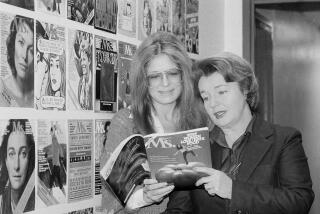Nan Robertson dies at 83; Pulitzer-winning New York Times reporter
Nan Robertson, a Pulitzer Prize-winning New York Times reporter who brought distinction and change to her newspaper through highly publicized professional and personal battles -- one against sex discrimination at her newspaper, the other against toxic shock syndrome, which nearly killed her -- died Tuesday at a nursing home in Rockville, Md. She was 83.
The cause was heart disease, said her stepdaughter-in-law, Jane Freundel Levey.
A reporter for the New York Times for 33 years beginning in 1955, Robertson was known for her role in a drive to improve pay and career opportunities for women writers and editors, which culminated in a class-action lawsuit settled in favor of the women plaintiffs in 1978. She chronicled the fight and the paper’s long history of discrimination against women in the 1992 book “The Girls in the Balcony.”
In 1983 she won a Pulitzer for a New York Times magazine article, “Toxic Shock,” a moving, often gruesome account of her struggle to survive toxic shock syndrome, which had struck her with brutal swiftness two years earlier. She was hospitalized for 11 weeks and lost the tips of eight fingers to gangrene but recovered fully and returned to the Times, where she covered cultural affairs until retiring in 1988.
“Nan Robertson was a superb journalist, a riveting writer and a dogged reporter,” said Gene Roberts Jr., a former managing editor of the New York Times and journalism professor at the University of Maryland, where Robertson also taught for several years after retiring from daily journalism. “She elevated journalism by insisting, and proving, that women could do whatever men could do in the craft, and probably better.”
Robertson was born in Chicago on July 11, 1926. She earned a journalism degree from Northwestern University in 1948 before becoming a European correspondent for several papers, including Stars & Stripes, the Milwaukee Journal and the New York Herald Tribune.
When she returned to the United States in 1955, she thought her foreign reporting credentials would help her land a good job at the New York Times. The paper hired her to write for the fashion department. After about five years, she worked her way out of the women’s pages to the city room, where she became a general assignment reporter. She showed such mettle scrambling for news that her mostly male colleagues paid her the ultimate compliment: “Nan, you write like a man.”
“They were absolutely equal in their treatment of me,” she said of the city desk editors. That experience changed drastically in 1963 when she transferred to the Times’ Washington bureau.
To her chagrin, she discovered that at the National Press Club, where national and international figures came to deliver major addresses, women reporters were second-class citizens. While their male colleagues covered the speeches of the high and mighty from comfortable seats in the club’s ballroom, the women were exiled to a balcony so small that chairs wouldn’t fit in it. The women took notes while standing and strained to see and hear the speaker from their remote perch. They were barred from asking questions of the speakers and had to enter and leave the club through a back door. It was so humiliating that Robertson and two other women from the Times refused to cover events at the club, but their protests brought little relief.
“It was discrimination at its rawest,” Robertson wrote in “The Girls in the Balcony.”
Near the end of her decade in the Washington bureau, Robertson joined a group of 50 women who signed a letter to Times management in 1972 protesting huge disparities in pay and other conditions. In 1973 six women (who were later joined by a seventh) sued the paper in a New York federal court. The lawsuit was settled out of court in 1978 for $350,000 and a pledge from top executives to implement an affirmative action plan.
In 1973, Robertson left Washington for a dream assignment as the Times’ correspondent in Paris. She left her European post two years later to enter treatment in New York for alcoholism, a problem that had worsened after her second husband, Stanley Levey, died during heart surgery in 1971. She later was hospitalized with a nervous breakdown. Her struggles with drinking led her to write “Getting Better: Inside Alcoholics Anonymous” (1988).
Divorced once and widowed twice, Robertson is survived by a sister, Jane Robertson Paetz; five stepchildren, Bob Levey, John Frank Levey, Mary Houghton, James Houghton and William P. Ross; and nine step-grandchildren.
Her cruelest ordeal unfolded during a Thanksgiving visit to Illinois in 1981. After the holiday meal with family, she experienced uncontrolled vomiting and diarrhea. Her arms and legs felt paralyzed, and she was disoriented. In the ambulance to the hospital, she heard a paramedic yell that she had no pulse, and her extremities were turning the color of ash. She developed a fever and fell into a coma. “I had never experienced such an incredible onslaught of illness,” she told People magazine later.
Luckily, an infectious disease specialist recognized her symptoms as toxic shock syndrome, a disease that had been given a name only a few years earlier. It typically struck menstruating women under 25 who used tampons, but about 15% of its victims were men, children and, like the then-55-year-old Robertson, non-menstruating women. Robertson was so ravaged by the massive infection that for the first four days her doctors believed she would die.
She was saved, she later wrote, by the “swift and superlative” treatment she received. But she was left with eight gangrenous fingers, the end joints of which had to be amputated. Without the tips of her fingers, she could not perform the simplest tasks for herself, such as opening a door or fastening a button.
The thought that most terrorized her, however, was that she would never again be able to bang out a story on her typewriter.
Weeks of grueling physical therapy proved her wrong.
“My deepest fear did not materialize,” she wrote in the article published on Sept. 19, 1982, barely 10 months after she had nearly lost her life.
“I have typed the thousands of words of this article, slowly and with difficulty, once again able to practice my craft as a reporter. I have written it -- at last -- with my own hands.”
More to Read
Start your day right
Sign up for Essential California for the L.A. Times biggest news, features and recommendations in your inbox six days a week.
You may occasionally receive promotional content from the Los Angeles Times.







